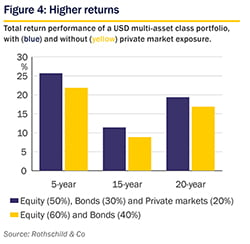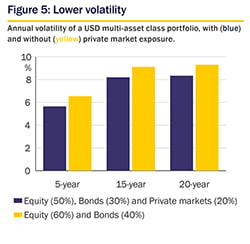Wealth Management: Investment Views – The rise of private markets

William Haggard, William Therlin, Amaya Gutiérrez, Raphaela Schröder and Andreas Doepfert, Wealth Management
Understanding private debt
What are the benefits of investing in private debt?
Turning from private equity to private debt, private debt offers investors an attractive alternative to investing in traditional fixed income strategies and is inherently more conservative in terms of risk and return than private equity.
The most common ways to invest in private debt are either via direct lending or syndicated loans. In direct lending, as with most private equity strategies, funds tend to be closed ended, meaning that once monies are invested, the position is illiquid. Nevertheless, private debt's lower volatility and regular cash income are attractive to investors.
Examples of direct lending funds are our Five Arrows Credit Solutions ( FACS) junior credit opportunities and Five Arrows Direct Lending ( FADL) funds. The latter invests in senior-secured direct loans for mid-market companies seeking financing for buyouts, expansion opportunities or refinancing.
Click the image to enlarge
Figure above is examples of the types of companies which FACS or FADL have lent to include Biogroup LCD, a leading network of French clinical laboratories, fast-food powerhouse Burger King, and Arachas, a leading Irish commercial insurance broker. The gross internal rate of return of direct lending funds such as FACS is around 12% and for FADL 8% to 10%. These returns tend to be higher than those obtained from lending via syndicated loans which are nearer 4% to 5%.
Syndicated loans have a lower rate of return given that they are issued by larger businesses (than DL) that have performed for longer and across cycles. The syndicated loans market also has the benefit of an active secondary market, making it more liquid in contrast to direct lending.
Rothschild & Co has considerable experience in participating in the syndicated loans market and currently offers three strategies: Oberon, Elsinore and CLOs. Our closed-ended (illiquid) Oberon funds invest in senior secured corporate loans in the European market.
Starting in 2018, we also launched our first open-ended fund in the US market which offers monthly liquidity. Oberon USA targets senior secured US corporate loans and a gross return of Libor +4% over credit cycles. With 192 new investments, 2018 was an active year for Oberon USA which lent to companies such as Cushman & Wakefield, and Energizer, the leading provider of batteries and torches in the US. Complementing Oberon, Elsinore is our actively managed multi-strategy credit portfolio investing in high-yielding sub-investment grade corporate debt. Because of its greater risk-return profile, it targets a higher net return of 8% to 10%.
Private markets for wealth management
Seeking returns with lower volatility
As we have illustrated, Rothschild & Co offers a broad range of private market strategies in keeping with the growing popularity of this asset class. With this in mind, we need to understand the benefits these strategies can bring private wealth clients within a standard multi-asset class portfolio.
Private market investments can diversify and lower volatility within portfolios
There are two key benefits private markets can bring to multi-asset class portfolios.
Firstly, private market investments allow for broader diversification of a multi-asset class portfolio as they access investment opportunities not typically available on the public markets. By being actively involved in key development stages of the companies they invest in, private equity and debt strategies can also give clients unique exposure to businesses as they grow. This in turn can add long-term positive returns to portfolios.
Secondly, private markets can reduce the overall level of portfolio volatility due to the fact they are generally less liquid in nature. This is due to the fact that managers need time to find the right companies to invest in, deploy capital and determine how to add value. As a result, they are not valued on a daily basis but rather on a quarterly basis. That being said, the rise of the secondary market has changed the face of private equity as the possibility to sell equity investments on the secondary market has increased.
Furthermore, even though private markets may be less liquid than public market investments, this does not mean private markets are per se less transparent. Regular account statements and communications by managers are issued to clients with comprehensive reporting.
To demonstrate these two positive effects, we have carried out a study to see how historically, private markets have added value within multi-asset class portfolios.
For this study, we tracked the performance of a USD multi-asset class portfolio, with (blue) and without (yellow) private markets exposure over the last five, 15 and 20 years.
Click the image to enlarge
Figure 4 shows that the blue portfolio delivered a higher total return and figure 5 shows that it achieved this with a lower volatility. This was achieved with a mix of 50% global equities, 30% fixed income and, crucially, 20% private markets. This private market exposure was divided equally between private debt and private equity.
By contrast, the yellow portfolio which did not contain private markets exposure but merely 60% equities and 40% fixed income, had a lower return and higher volatility for the three periods studied.4
Another key feature of the study is that the blue portfolio outperformed the yellow portfolio both in periods of strong equity markets and in periods with deep market falls during the last 20 years. This includes during the 'dot-com crisis' in the early 2000s and the 2008 Global Financial Crisis.
4 The results are obtained with historical data based on 60% MSCI AC Index and 40% Fixed income (divided into 20% Government bonds; 16.8% Corporate bonds; 3.2% High yield). For private markets, we use the Cambridge Associates LLC US Private Equity Index and the CS Leveraged Loan Total Return Index.
Click here to continue: Investment Views - Managing a direct lending fund
In this Investment Views:
-
Foreword
-
Why private markets matters
-
Understanding private Equity
-
Understanding private debt (current page)
-
Managing a direct lending fund
-
Investing with Rothschild & Co
-
Important information
Download the full The rise of private markets in PDF format (1.31 MB)


